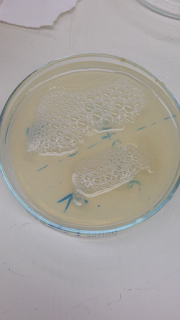The starch test was negative meaning our bacteria did not use starch, a carbohydrate made from glucose. The use of starch is by alpha-amylase enzyme.
 |
| Our negative starch hydrolysis plate |
The casein test was negative meaning our bacteria did not use casein. The gelatin test showed some liquid but after it was placed in the refrigerator, there was no liquid, meaning the test was negative and our bacteria did not use gelatin. Our lipid triglyceride test was negative meaning our bacteria did not use lipid. There an no enzymes that can break the lipid.
Next, we analyzed our bacteria's ability to ferment carbohydrates. Our results showed:
Lactose: Bubbles were present (presence of gas); the color changed to yellow. There was bacterial growth in the tube.
Glucose: Bubbles were present (presence of gas); the color changed to yellow. There was bacterial growth in the tube.
Sucrose: There was on tiny bubble at the top (small presence of gas); the color remained orange-red (no color change). There was bacterial growth in the tube.
Maltose: Bubbles were present (presence of gas); the color changed to yellow. There was bacterial growth in the tube.
 |
| All positive but sucrose |
Our next test was the methyl-red and Voges-Proskaus tests. We poured half of the liquid into a clean test tube and put 8 drops of methyl red dye into the tube. This test was to determine if we have E. Coli or not. To follow to test, we used 5 drops of B reagent and 15 drops of A reagent. The test was positive, allowing us to highly consider E. coli as our unknown bacteria!!
The Voges-Proskaus was next. This test was to determine that if there was butanediol, there would be a color produced. The bacteria would be E. aregenous if a rose color was produced. There was no color produced so the test was negative.
The Voges-Proskaus was next. This test was to determine that if there was butanediol, there would be a color produced. The bacteria would be E. aregenous if a rose color was produced. There was no color produced so the test was negative.
 |
| Our negative VP and positive MR tests |
 |
| THE RED LINE! |
For the nitrate test, the first step was to add 10 drops of A-sulfanilic acid and 10 drops of B- dimethyl- α-naphthylamine to the tube. Our liquid turned pink so we didn't need to add the zinc powder. Our results were positive and our bacteria used nitrate to produce nitrite.
 |
| Positive nitrite test because of that bright color change! |
For the TSAI test which used 0.1% glucose and 1.0% lactose and sucrose, our slant turned yellow meaning acid was produced and our acid butt was positive also However, our results were negative for H2S.
The urea test was negative so our bacteria did not contain urease.
The litmus test allowed us to find out whether our bacteria uses lactose, protein, and litmus.The litmus test showed a color change from purple to a pinkish purple. This test was negative for gas because no fissures were produced. The test was positive for using lactose to produce lactic acid. We had a white acid curd at the bottom of the tube meaning litmus was reduced.
 |
| Our acid curd |

The GasPac test was positive for growth, allowing use to know our bacteria is falcultated (grows under aerobic and anaerobic conditions). The thyogylcolate test also proved our bacteria is falcultated because there was bacterial growth in the middle and top of the tube.
 |
| Growth on the top and middle |
 |
| The backside of the growth |
 |
| Our bacteria grew under anaerobic conditions too! |
 |
| Bubbles! |
The oxidase test was negative because there was no color change. We added the reagent onto filter paper and applied the bacteria on the color change. The results were negative.
The citrate test was negative. We inoculated the tube with our unknown bacteria and inoculated it at 37°C overnight. If the tube turned blue, the test would have been positive. However, our tube remained green.
 |
| Our negative citrate test |
We also tried to make yogurt but that turned out to be not as successful as we had hoped.
 |
| Our yogurt samples |
No comments:
Post a Comment